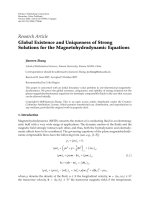Happy About Global Software Test Automation Book Excerpt A Discussion of Software Testing for Executives phần 1 potx
Bạn đang xem bản rút gọn của tài liệu. Xem và tải ngay bản đầy đủ của tài liệu tại đây (99 KB, 10 trang )
20660 Stevens Creek Blvd.
Suite 210
Cupertino, CA 95014
“Happy About®
Global Software
Test Automation”
Book Excerpt
A Discussion of Software Testing
for Executives
By Hung Q. Nguyen,
Michael Hackett and
Brent K. Whitlock
Subset of the book brought
to you by Happy About
WHITE PAPER Table of Contents (included here)
• Chapter 3: The Pitfalls of Manual Software Testing
• About the Authors, Hung Q. Nguyen, Michael Hackett and Brent K.
Whitlock
• Getting the book and other books from Happy About
Getting “Happy About Global Software Test Automation”
(o/globalswtestautomation.php)
“Happy About Global Software Test Automation” can be purchased as
an eBook for $11.95 or tradebook for $19.95 at:
o/globalswtestautomation.php
or at other
online and physical book stores.
Please contact us for quantity discounts
or to
be informed about upcoming titles
or phone (408-257-3000).
Contents
Happy About Global Software Test Automation iii
NOTE: This is the Table of Contents (TOC) from the book for
your reference. The eBook TOC (below) differs in page
count from the tradebook TOC.
Chapter 1 The Business Side of Software Testing. . . . 1
Introduction. . . . . . . . . . . . . . . . . . . . . . . . . . . . . . . . .2
Summary . . . . . . . . . . . . . . . . . . . . . . . . . . . . . . . . . .9
Chapter 2 An Overview of Software Testing . . . . . . . . 11
Introduction. . . . . . . . . . . . . . . . . . . . . . . . . . . . . . . .12
Relationship with Quality Assurance . . . . . . . . . . . .12
Visibility. . . . . . . . . . . . . . . . . . . . . . . . . . . . . . . . . . .13
Metrics . . . . . . . . . . . . . . . . . . . . . . . . . . . . . . . . . . .15
Quality Cost . . . . . . . . . . . . . . . . . . . . . . . . . . . . . . .17
An Example of Quality Cost . . . . . . . . . . . . . . . . . . .21
Types of Software Testing . . . . . . . . . . . . . . . . . . . .22
The Products of Software Testing . . . . . . . . . . . . . .24
What Makes Good Testing?. . . . . . . . . . . . . . . . . . .25
Common Misconceptions About
Software Testing. . . . . . . . . . . . . . . . . . . . . . . . . . . .28
Budgeting for Testing . . . . . . . . . . . . . . . . . . . . . . . .30
Relationship Between Software Development
Methodologies and Testing . . . . . . . . . . . . . . . . . . .31
Summary . . . . . . . . . . . . . . . . . . . . . . . . . . . . . . . . .34
Chapter 3 The Pitfalls of Manual Software
Testing. . . . . . . . . . . . . . . . . . . . . . . . . . . . . . 37
Introduction. . . . . . . . . . . . . . . . . . . . . . . . . . . . . . . .38
The Top Five Pitfalls of Manual Software
Testing . . . . . . . . . . . . . . . . . . . . . . . . . . . . . . . . . . .38
The Top Five Suggestions . . . . . . . . . . . . . . . . . . . .40
Case Studies . . . . . . . . . . . . . . . . . . . . . . . . . . . . . .42
Summary . . . . . . . . . . . . . . . . . . . . . . . . . . . . . . . . .45
Chapter 4 The Pitfalls of Test Automation . . . . . . . . . 47
Introduction. . . . . . . . . . . . . . . . . . . . . . . . . . . . . . . .48
The Top Five Pitfalls of Test Automation . . . . . . . . .51
iv Contents
The Top Five Suggestions . . . . . . . . . . . . . . . . . . . . 56
Case Studies . . . . . . . . . . . . . . . . . . . . . . . . . . . . . . 59
Summary . . . . . . . . . . . . . . . . . . . . . . . . . . . . . . . . . 65
Chapter 5 The Pitfalls of Outsourcing/Offshoring
Software Testing . . . . . . . . . . . . . . . . . . . . . . 67
Introduction . . . . . . . . . . . . . . . . . . . . . . . . . . . . . . . 68
The Top 5 Pitfalls of Outsourcing/Offshoring
Software Testing . . . . . . . . . . . . . . . . . . . . . . . . . . . 68
The Top Five Suggestions . . . . . . . . . . . . . . . . . . . . 84
Case Studies . . . . . . . . . . . . . . . . . . . . . . . . . . . . . . 87
Summary . . . . . . . . . . . . . . . . . . . . . . . . . . . . . . . . . 92
Chapter 6 Strategies and Tactics for Global Test
Automation. . . . . . . . . . . . . . . . . . . . . . . . . . . 93
Introduction . . . . . . . . . . . . . . . . . . . . . . . . . . . . . . . 93
What is Global Test Automation (GTA)? . . . . . . . . . 94
An Exercise for the Reader . . . . . . . . . . . . . . . . . . . 95
An Illustration of the Issues . . . . . . . . . . . . . . . . . . . 96
Strategy Formulation . . . . . . . . . . . . . . . . . . . . . . . . 97
Step 1: Assess your Testing Needs. . . . . . . . . . . . . 99
Implementation. . . . . . . . . . . . . . . . . . . . . . . . . . . . 102
Step 2: Align your Test Process. . . . . . . . . . . . . . . 104
Step 3: Leverage Automation. . . . . . . . . . . . . . . . . 108
Case Study: Centrify Corporation . . . . . . . . . . . . . 112
Step 4: Minimize Costs and Risks of
Global Resources. . . . . . . . . . . . . . . . . . . . . . . . . . 113
Step 5: Select the Right Tool . . . . . . . . . . . . . . . . . 114
About ABT . . . . . . . . . . . . . . . . . . . . . . . . . . . . . . . 117
Case Study: Openwave Corporation . . . . . . . . . . . 127
Step 6: Secure/Develop Competency . . . . . . . . . . 128
Step 7: Measure, Analyze, and Optimize. . . . . . . . 133
Summary . . . . . . . . . . . . . . . . . . . . . . . . . . . . . . . . 137
Chapter 7 Conclusion. . . . . . . . . . . . . . . . . . . . . . . . . . 141
Introduction . . . . . . . . . . . . . . . . . . . . . . . . . . . . . . 141
Summary . . . . . . . . . . . . . . . . . . . . . . . . . . . . . . . . 150
Authors About the Authors . . . . . . . . . . . . . . . . . . . . . . . . 151
About LogiGear® . . . . . . . . . . . . . . . . . . . . . . . . . . 153
About TestArchitect™ . . . . . . . . . . . . . . . . . . . . . . 154
Happy About Global Software Test Automation 1
Chapter
3
The Pitfalls of
Manual Software
Testing
In this chapter, we will present the top five
pitfalls of manual software testing, listed
below:
1. Manual testing is slow and costly.
2. Manual tests don’t scale well.
3. Manual testing is not consistent or
repeatable.
4. Lack of training.
5. Testing is difficult to manage.
We will then present the top five
suggestions, listed below:
1. Be thorough in test design and
documentation.
2. Automate the turnkey tests as much as
possible.
3. Manage the test activities well.
4. Rank test cases in order of importance.
5. Have a separate budget with proper
funding for testing.
We will then present some case studies that
illustrate the issues.
2 Chapter 3: The Pitfalls of Manual Software Testing
Introduction
Manual software testing has been the cornerstone of software testing.
All test engineers and software QA staff, software engineers,
developers, and programmers test their code manually, at least to
some degree. Manual software testing is employed with all sizes of
projects and budgets, ranging from zero to billions of dollars. It is a
critical element of software testing, but not the be-all and end-all.
Furthermore, it is not synonymous with quality assurance. Just as in
software development, the quality of the results of manual software
testing can vary widely depending on many factors.
The Top Five Pitfalls of Manual Software
Testing
Manual software testing is a necessity, and an unavoidable part of the
software product development process. How much testing you do
manually, as compared to using test automation, can make the
difference between a project’s success and failure. We will discuss test
automation in more detail in a later chapter, but the top five pitfalls of
manual software testing illuminate areas where improvements can be
made. The pitfalls are listed and described below:
1. Manual testing is slow and costly. Because it is very
labor-intensive, it takes a long time to complete tests. To try to
accelerate testing, you may increase the headcount of the test
organization. This increases the labor as well as the
communication costs.
2. Manual tests don’t scale well. As the complexity of the software
increases, the complexity of the testing problem grows
exponentially. If tests are detailed and must be performed
manually, performing them can take quite a bit of time and effort.
This leads to an increase in the total time devoted to testing as
well as the total cost of testing. Even with these increases in the
time and cost, the test coverage goes down as the complexity
goes up because of the exponential growth rate.
Happy About Global Software Test Automation 3
3. Manual testing is not consistent or repeatable. Variations in
how the tests are performed are inevitable, for various reasons.
One tester may approach and perform a certain test differently
from another, resulting in different results on the same test,
because the tests are not being performed identically. As another
example, if there are differences in the location a mouse is
pointed when its button is clicked, or how fast operations are
performed, these could potentially produce different results.
4. Lack of training is a common problem, although not unique
to manual software testing. The staff should be well-trained in
the different phases of software testing:
– Test design
– Test execution
– Test result evaluation
5. Testing is difficult to manage. There are more unknowns and
greater uncertainty in testing than in code development. Modern
software development practices are well-structured, but if you
don’t have sufficient structure in testing, it will be difficult to
manage. Consider a case in which the development phase of a
project schedule slips. Since manual software testing takes more
time, more resources, and is costly, that schedule slip can be
difficult to manage. A delay in getting the software to the test team
on schedule can result in significant wasted resources. Manual
testing, as well as badly designed automated testing, are also not
agile. Therefore, changes in test focus or product requirements
make these efforts even more difficult to manage.
The Top Five Suggestions
There are ways that pitfalls associated with manual software testing
can be avoided or resolved. In this section, we discuss five of these.
1. Be thorough in test design and documentation. In designing
the tests, there should be agreement among the business staff,
product and project managers, developers, and testers on test
coverage. This can be documented as test requirements in a test
plan. With this documentation, management can have visibility
4 Chapter 3: The Pitfalls of Manual Software Testing
into the test coverage and know that the right areas are being
tested. This then becomes an important management tool in
managing testing.
The goal is to find the easiest way to document as many test cases as
possible without having the test effort turn into a documentation effort.
Have the test requirements and test cases peer-reviewed, just as
you would have software design reviews. The software
development staff and the test staff should jointly develop the test
designs, as they have complementary skill sets and knowledge
bases.
In manual testing, like in other processes, several factors influence
the effectiveness of the tests, including the completeness of the
test cases and the thoroughness of the documentation. The goal
should be to maximize management’s understanding of the testing
by spending the appropriate resources in each area, within the
overall resource constraints. If you don’t document your tests, you
won’t understand the coverage or software quality as revealed by
the tests, and you also won’t be able to determine that the test
team is testing features that are the most important to your
development team and customers. However, if you document
everything related to each test case, you won’t have time to do as
many tests as you should. Documenting test cases can get
expensive. The goal is to find the easiest way to document as
many test cases as possible, without having the test effort turn into
a documentation effort.
2. Automate the turnkey tests as much as possible. There are
various tools available that support test automation. When it is
cost-effective and time-efficient to do so, there is no excuse for
not automating software tests. The benefit of automation is that
the testing becomes less burdensome, and less likely to be
scrimped on when under pressure. This also makes the testing
easier to manage.
Happy About Global Software Test Automation 5
“Software testing is surprisingly low-tech, and requires too much
‘hands-on.’ Would most people run their virus software frequently if they
had to invoke it manually?”
—Sue Kunz, CEO of SolidWare Technologies
3. Manage the test activities well. Do this as closely, and by
establishing as full a procedure, as the software development
activities. Be sure that the project plan has sufficient resources
and time allocated to testing so that it doesn’t get short shrift.
4. Rank test cases in order of importance, by impact on quality,
by risk, by how often the feature tested is used, or some
other related metric. A goal should be to run all important test
cases, but if there are resource constraints that prevent all test
cases from being run, then the ranking will enable the important
test cases to be run. This provides the maximum impact of the
testing with the available resources. In manual software testing,
you are always short on time. There should be an agreement or
signoff procedure on the ranking and the coverage of the tests.
5. Have a separate budget with proper funding allocated for
testing. Just as there is a budget allocated for the software code
development, there should be a budget allocated for testing. Be
sure that this budget is well-funded. Watch how much is spent on
testing, and what the return on investment is.
Even when you have a good test automation program in place, you will
still need to do some manual testing. The usability testing, for example,
requires human involvement. However, manual testing is not the
solution for short-cycle, high-volume test challenges. For example, if
you have a daily build process where you need to run smoke-tests to
assess the changes and stability of the software from build to build,
these tests can be high-volume and short-cycle. Manual testing cannot
solve your testing problem in this case.









